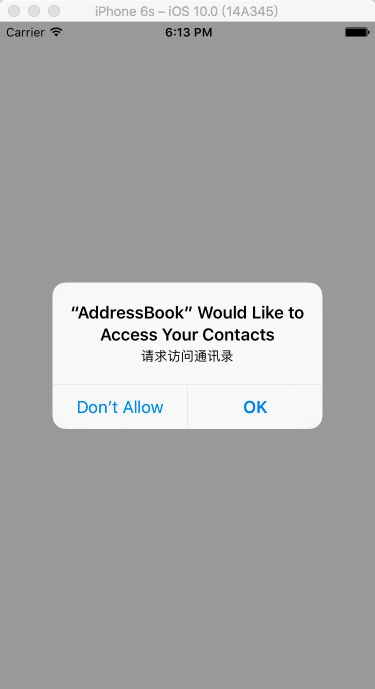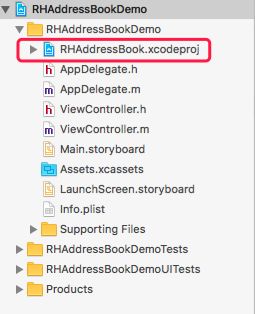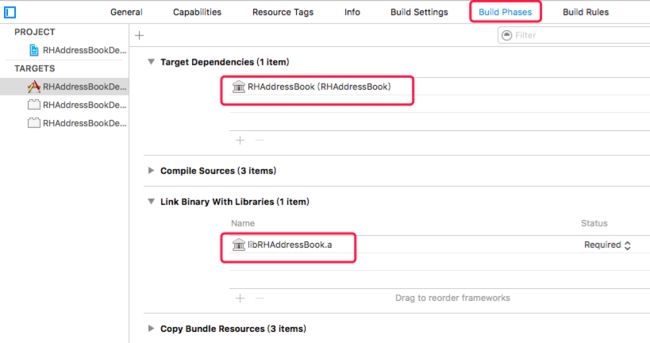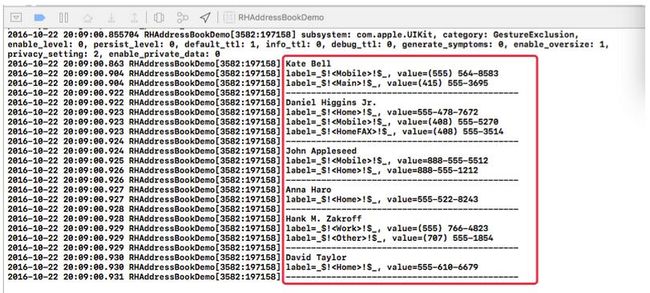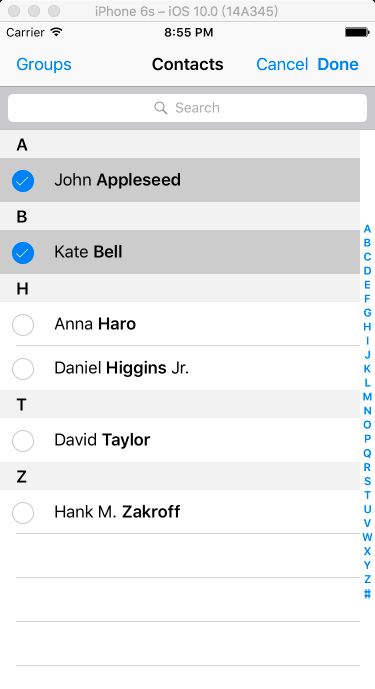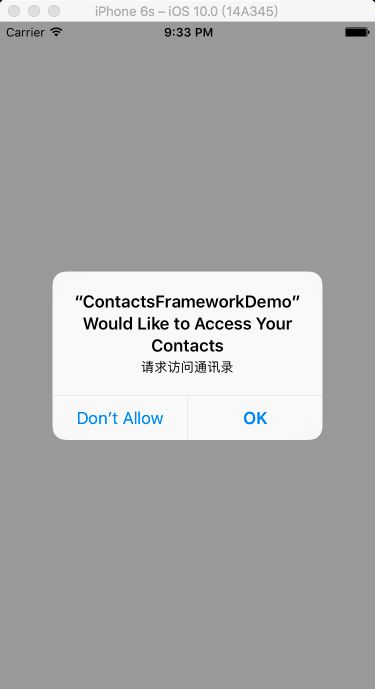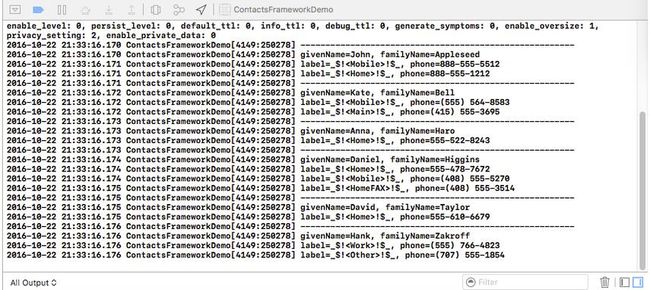分享了iOS获取通讯录的4种方式
本文实例为大家分享了iOS获取通讯录的4种方式,供大家参考,具体内容如下
使用场景
一些App通过手机号码来推荐好友,如 微博、支付宝
首先客户端会获取通讯录中的所有手机号然后将这些手机号提交到App服务器中,服务器会查找每个手机号对应的App账号如QQ号码返回到客户端,然后客户端根据服务器返回的账号列表来推荐好友。
获取联系人方式
方案一:AddressBookUI.framework框架
提供了联系人列表界面、联系人详情界面、添加联系人界面等
一般用于选择联系人
方案二:AddressBook.framework框架:
没有提供UI界面,需要自己搭建联系人界面
纯C语言的API, 仅仅是获得联系人数据
大部分数据类型是Core Foundation
从iOS6 开始,需要得到用户的授权才能访问通讯录
方案三:第三方框架:RHAddressBook
对 AddressBook.framework 进行封装
方案四:iOS9.0最新通讯录框架
ContactsUI.framework : 方案1的替代品,特点: 面向对象,使用简单,有界面
Contacts.framework: 方案2的替代品, 特点:面向对象,使用简单,五界面
方案一:AddressBookUI.framework
实现步骤:
1.创建选择联系人的控制器
2.设置代理:用来接收用户选择的联系人信息
3.弹出联系人控制器
4.实现代理方法
5.在对应的代理方法中获取联系人信息
AddressBook.frame实现步骤:
1.请求授权
2.判断授权状态如果已授权则继续,如果未授权则提示用户
3.创建通讯录对象
4.从通讯录中获取所有的联系人
5.遍历所有的联系人
6.释放不再使用的对象
AddreesBook.framework具体实现:
1. AppDelegate 应用启动时请求授权
|
1
2
3
4
5
6
7
8
9
10
11
12
13
14
15
16
17
18
19
20
21
22
23
24
25
26
27
28
29
30
31
32
33
|
#import "AppDelegate.h"
#import
@interface AppDelegate ()
@end
@implementation AppDelegate
- (
BOOL
)application:(UIApplication *)application didFinishLaunchingWithOptions:(NSDictionary *)launchOptions {
// Override point for customization after application launch.
[self requestAuthorizationAddressBook];
return
YES;
}
- (
void
)requestAuthorizationAddressBook {
// 判断是否授权
ABAuthorizationStatus authorizationStatus = ABAddressBookGetAuthorizationStatus();
if
(authorizationStatus == kABAuthorizationStatusNotDetermined) {
// 请求授权
ABAddressBookRef addressBookRef = ABAddressBookCreate();
ABAddressBookRequestAccessWithCompletion(addressBookRef, ^(
bool
granted, CFErrorRef error) {
if
(granted) {
// 授权成功
}
else
{
// 授权失败
NSLog(@
"授权失败!"
);
}
});
}
}
@end
|
2. iOS10 需要在Info.plist配置NSContactsUsageDescription
|
1
2
|
|
3. ViewController
|
1
2
3
4
5
6
7
8
9
10
11
12
13
14
15
16
17
18
19
20
21
22
23
24
25
26
27
28
29
30
31
32
33
34
35
36
37
38
39
40
41
42
43
44
45
46
47
48
49
50
51
52
53
54
55
56
57
58
59
60
61
62
63
64
65
66
67
68
69
70
71
72
73
74
75
76
77
78
79
80
81
82
83
84
85
86
87
88
89
90
91
92
93
94
95
96
97
98
99
100
101
102
103
104
105
106
107
108
109
110
111
112
113
114
115
116
117
118
119
120
121
122
123
124
|
#import "ViewController.h"
#import
@interface ViewController ()
@end
@implementation ViewController
- (
void
)viewDidLoad {
[super viewDidLoad];
}
- (
void
)touchesBegan:(NSSet
// 1. 判读授权
ABAuthorizationStatus authorizationStatus = ABAddressBookGetAuthorizationStatus();
if
(authorizationStatus != kABAuthorizationStatusAuthorized) {
NSLog(@
"没有授权"
);
return
;
}
// 2. 获取所有联系人
ABAddressBookRef addressBookRef = ABAddressBookCreate();
CFArrayRef arrayRef = ABAddressBookCopyArrayOfAllPeople(addressBookRef);
long
count = CFArrayGetCount(arrayRef);
for
(
int
i = 0; i < count; i++) {
//获取联系人对象的引用
ABRecordRef people = CFArrayGetValueAtIndex(arrayRef, i);
//获取当前联系人名字
NSString *firstName=(__bridge NSString *)(ABRecordCopyValue(people, kABPersonFirstNameProperty));
//获取当前联系人姓氏
NSString *lastName=(__bridge NSString *)(ABRecordCopyValue(people, kABPersonLastNameProperty));
NSLog(@
"--------------------------------------------------"
);
NSLog(@
"firstName=%@, lastName=%@"
, firstName, lastName);
//获取当前联系人的电话 数组
NSMutaleArray *phoneArray = [[NSMutableArray alloc]init];
ABMultiValueRef phones = ABRecordCopyValue(people, kABPersonPhoneProperty);
for
(NSInteger j=0; j
NSString *phone = (__bridge NSString *)(ABMultiValueCopyValueAtIndex(phones, j));
NSLog(@
"phone=%@"
, phone);
[phoneArray addObject:phone];
}
//获取当前联系人的邮箱 注意是数组
NSMutableArray *emailArray = [[NSMutableArray alloc]init];
ABMultiValueRef emails= ABRecordCopyValue(people, kABPersonEmailProperty);
for
(NSInteger j=0; j
NSString *email = (__bridge NSString *)(ABMultiValueCopyValueAtIndex(emails, j));
NSLog(@
"email=%@"
, email);
[emailArray addObject:email];
}
//获取当前联系人中间名
NSString *middleName=(__bridge NSString*)(ABRecordCopyValue(people, kABPersonMiddleNameProperty));
//获取当前联系人的名字前缀
NSString *prefix=(__bridge NSString*)(ABRecordCopyValue(people, kABPersonPrefixProperty));
//获取当前联系人的名字后缀
NSString *suffix=(__bridge NSString*)(ABRecordCopyValue(people, kABPersonSuffixProperty));
//获取当前联系人的昵称
NSString *nickName=(__bridge NSString*)(ABRecordCopyValue(people, kABPersonNicknameProperty));
//获取当前联系人的名字拼音
NSString *firstNamePhoneic=(__bridge NSString*)(ABRecordCopyValue(people, kABPersonFirstNamePhoneticProperty));
//获取当前联系人的姓氏拼音
NSString *lastNamePhoneic=(__bridge NSString*)(ABRecordCopyValue(people, kABPersonLastNamePhoneticProperty));
//获取当前联系人的中间名拼音
NSString *middleNamePhoneic=(__bridge NSString*)(ABRecordCopyValue(people, kABPersonMiddleNamePhoneticProperty));
//获取当前联系人的公司
NSString *organization=(__bridge NSString*)(ABRecordCopyValue(people, kABPersonOrganizationProperty));
//获取当前联系人的职位
NSString *job=(__bridge NSString*)(ABRecordCopyValue(people, kABPersonJobTitleProperty));
//获取当前联系人的部门
NSString *department=(__bridge NSString*)(ABRecordCopyValue(people, kABPersonDepartmentProperty));
//获取当前联系人的生日
NSString *birthday=(__bridge NSDate*)(ABRecordCopyValue(people, kABPersonBirthdayProperty));
//获取当前联系人的备注
NSString *notes=(__bridge NSString*)(ABRecordCopyValue(people, kABPersonNoteProperty));
//获取创建当前联系人的时间 注意是NSDate
NSDate *creatTime=(__bridge NSDate*)(ABRecordCopyValue(people, kABPersonCreationDateProperty));
//获取最近修改当前联系人的时间
NSDate *alterTime=(__bridge NSDate*)(ABRecordCopyValue(people, kABPersonModificationDateProperty));
//获取地址
ABMultiValueRef address = ABRecordCopyValue(people, kABPersonAddressProperty);
for
(
int
j=0; j
//地址类型
NSString *type = (__bridge NSString *)(ABMultiValueCopyLabelAtIndex(address, j));
NSDictionary * tempDic = (__bridge NSDictionary *)(ABMultiValueCopyValueAtIndex(address, j));
//地址字符串,可以按需求格式化
NSString *adress = [NSString stringWithFormat:@
"国家:%@\n省:%@\n市:%@\n街道:%@\n邮编:%@"
,[temDic valueForKey:(NSString*)kABPersonAddressCountryKey],[tempDic valueForKey:(NSString*)kABPersonAddressStateKey],[tempDic valueForKey:(NSString*)kABPersonAddressCityKey],[tempDic valueForKey:(NSString*)kABPersonAddressStreetKey],[tempDic valueForKey:(NSString*)kABPersonAddressZIPKey]];
}
//获取当前联系人头像图片
NSData *userImage=(__bridge NSData*)(ABPersonCopyImageData(people));
//获取当前联系人纪念日
NSMutableArray *dateArr = [[NSMutableArray alloc]init];
ABMultiValueRef dates= ABRecordCopyValue(people, kABPersonDateProperty);
for
(NSInteger j=0; j
//获取纪念日日期
NSDate *data =(__bridge NSDate*)(ABMultiValueCopyValueAtIndex(dates, j));
//获取纪念日名称
NSString *str =(__bridge NSString*)(ABMultiValueCopyLabelAtIndex(dates, j));
NSDictionary *tempDic = [NSDictionary dictionaryWithObject:data forKey:str];
[dateArr addObject:tempDic];
}
}
}
@end
|
4. 运行结果
第三方框架:RHAddressBook
https://github.com/heardrwt/RHAddressBook
该框架使用的MRC来管理内存的,如果直接将源代码拖入进去需要为每个文件设置编译标记:-fno-objc-arc, 设置完还会报错,该项目使用的一些方法过于古老,很多都不支持了,所以这种方式不采用; 可以将该项目打成静态库的方式;也可以直接将项目拖入到自己的工程中作为一个依赖
1.直接将RHAddressBook.xcodeproj拖入到工程中
2.添加Target Dependencies和Link Binary With Libraries
3.Build Settings—> Other Linker Flags : -ObjC
用于解决系统分类找不到方法的错误
4.iOS10 需要在Info.plist配置NSContactsUsageDescription
|
1
2
|
|
App启动时请求授权访问通讯录
|
1
2
3
4
5
6
7
8
9
10
11
12
13
14
15
16
17
18
19
20
21
22
23
24
25
26
27
28
29
30
|
#import "AppDelegate.h"
#import
@interface AppDelegate ()
@end
@implementation AppDelegate
- (
BOOL
)application:(UIApplication *)application didFinishLaunchingWithOptions:(NSDictionary *)launchOptions {
// Override point for customization after application launch.
[self requestAuthorizationForAddressBook];
return
YES;
}
- (
void
)requestAuthorizationForAddressBook {
RHAddressBook *ab = [[RHAddressBook alloc] init];
if
([RHAddressBook authorizationStatus] == RHAuthorizationStatusNotDetermined){
[ab requestAuthorizationWithCompletion:^(
bool
granted, NSError *error) {
if
(granted) {
}
else
{
NSLog(@
"请求授权拒绝"
);
}
}];
}
}
@end
|
获取所有联系人的信息:姓名、手机号等
|
1
2
3
4
5
6
7
8
9
10
11
12
13
14
15
16
17
18
19
20
21
22
23
24
25
26
27
28
29
30
31
32
33
34
35
36
37
|
#import "ViewController.h"
#import
#import
@interface ViewController ()
@end
@implementation ViewController
- (
void
)viewDidLoad {
[super viewDidLoad];
}
- (
void
)touchesBegan:(NSSet
RHAddressBook *addressBook = [[RHAddressBook alloc] init];
if
([RHAddressBook authorizationStatus] != RHAuthorizationStatusAuthorized){
NSLog(@
"没有授权"
);
return
;
}
NSArray *peopleArray= addressBook.people;
for
(
int
i = 0; i < peopleArray.count; i++) {
RHPerson *people = (RHPerson *)peopleArray[i];
NSLog(@
"%@"
, people.name);
RHMultiStringValue *phoneNumbers = people.phoneNumbers;
for
(
int
i = 0; i < phoneNumbers.count; i++) {
NSString* label= [phoneNumbers labelAtIndex:i];
NSString* value= [phoneNumbers valueAtIndex:i];
NSLog(@
"label=%@, value=%@"
, label, value);
}
NSLog(@
"----------------------------------------------"
);
}
}
@end
|
运行结果:
ContactsUI.framework
|
1
2
3
4
5
6
7
8
9
10
11
12
13
14
15
16
17
18
19
20
21
22
23
24
25
26
27
28
29
30
31
32
33
34
35
36
37
38
39
40
41
42
43
44
45
46
47
48
49
50
51
|
#import "ViewController.h"
#import
@interface ViewController ()
@end
@implementation ViewController
- (
void
)viewDidLoad {
[super viewDidLoad];
CNContactPickerViewController *contactPickerViewController = [[CNContactPickerViewController alloc] init];
contactPickerViewController.delegate = self;
[self presentViewController:contactPickerViewController animated:YES completion:nil];
}
// 如果实现该方法当选中联系人时就不会再出现联系人详情界面, 如果需要看到联系人详情界面只能不实现这个方法,
- (
void
)contactPicker:(CNContactPickerViewController *)picker didSelectContact:(CNContact *)contact {
NSLog(@
"选中某一个联系人时调用---------------------------------"
);
[self printContactInfo:contact];
}
// 同时选中多个联系人
- (
void
)contactPicker:(CNContactPickerViewController *)picker didSelectContacts:(NSArray
for
(CNContact *contact in contacts) {
NSLog(@
"================================================"
);
[self printContactInfo:contact];
}
}
- (
void
)printContactInfo:(CNContact *)contact {
NSString *givenName = contact.givenName;
NSString *familyName = contact.familyName;
NSLog(@
"givenName=%@, familyName=%@"
, givenName, familyName);
NSArray * phoneNumbers = contact.phoneNumbers;
for
(CNLabeledValue
NSString *label = phone.label;
CNPhoneNumber *phonNumber = (CNPhoneNumber *)phone.value;
NSLog(@
"label=%@, value=%@"
, label, phonNumber.stringValue);
}
}
// 注意:如果实现该方法,上面那个方法就不能实现了,这两个方法只能实现一个
//- (void)contactPicker:(CNContactPickerViewController *)picker didSelectContactProperty:(CNContactProperty *)contactProperty {
// NSLog(@"选中某个联系人的某个属性时调用");
//}
@end
|
选择单个联系人时运行效果:
选择多个联系人的界面:
Contact.framework
iOS10 需要在Info.plist配置NSContactsUsageDescription
|
1
2
|
|
应用启动时请求授权:
|
1
2
3
4
5
6
7
8
9
10
11
12
13
14
15
16
17
18
19
20
21
22
23
24
25
26
27
28
29
30
31
32
|
#import "AppDelegate.h"
#import
@interface AppDelegate ()
@end
@implementation AppDelegate
- (
BOOL
)application:(UIApplication *)application didFinishLaunchingWithOptions:(NSDictionary *)launchOptions {
// Override point for customization after application launch.
[self requestAuthorizationForAddressBook];
return
YES;
}
- (
void
)requestAuthorizationForAddressBook {
CNAuthorizationStatus authorizationStatus = [CNContactStore authorizationStatusForEntityType:CNEntityTypeContacts];
if
(authorizationStatus == CNAuthorizationStatusNotDetermined) {
CNContactStore *contactStore = [[CNContactStore alloc] init];
[contactStore requestAccessForEntityType:CNEntityTypeContacts completionHandler:^(
BOOL
granted, NSError * _Nullable error) {
if
(granted) {
}
else
{
NSLog(@
"授权失败, error=%@"
, error);
}
}];
}
}
@end
|
获取通讯录信息
|
1
2
3
4
5
6
7
8
9
10
11
12
13
14
15
16
17
18
19
20
21
22
23
24
25
26
27
28
29
30
31
32
33
34
35
36
37
38
39
40
41
42
43
44
|
#import "ViewController.h"
#import
@interface ViewController ()
@end
@implementation ViewController
- (
void
)viewDidLoad {
[super viewDidLoad];
}
- (
void
)touchesBegan:(NSSet
CNAuthorizationStatus authorizationStatus = [CNContactStore authorizationStatusForEntityType:CNEntityTypeContacts];
if
(authorizationStatus == CNAuthorizationStatusAuthorized) {
NSLog(@
"没有授权..."
);
}
// 获取指定的字段,并不是要获取所有字段,需要指定具体的字段
NSArray *keysToFetch = @[CNContactGivenNameKey, CNContactFamilyNameKey, CNContactPhoneNumbersKey];
CNContactFetchRequest *fetchRequest = [[CNContactFetchRequest alloc] initWithKeysToFetch:keysToFetch];
CNContactStore *contactStore = [[CNContactStore alloc] init];
[contactStore enumerateContactsWithFetchRequest:fetchRequest error:nil usingBlock:^(CNContact * _Nonnull contact,
BOOL
* _Nonnull stop) {
NSLog(@
"-------------------------------------------------------"
);
NSString *givenName = contact.givenName;
NSString *familyName = contact.familyName;
NSLog(@
"givenName=%@, familyName=%@"
, givenName, familyName);
NSArray *phoneNumbers = contact.phoneNumbers;
for
(CNLabeledValue *labelValue in phoneNumbers) {
NSString *label = labelValue.label;
CNPhoneNumber *phoneNumber = labelValue.value;
NSLog(@
"label=%@, phone=%@"
, label, phoneNumber.stringValue);
}
// *stop = YES; // 停止循环,相当于break;
}];
}
@end
|
运行效果:
